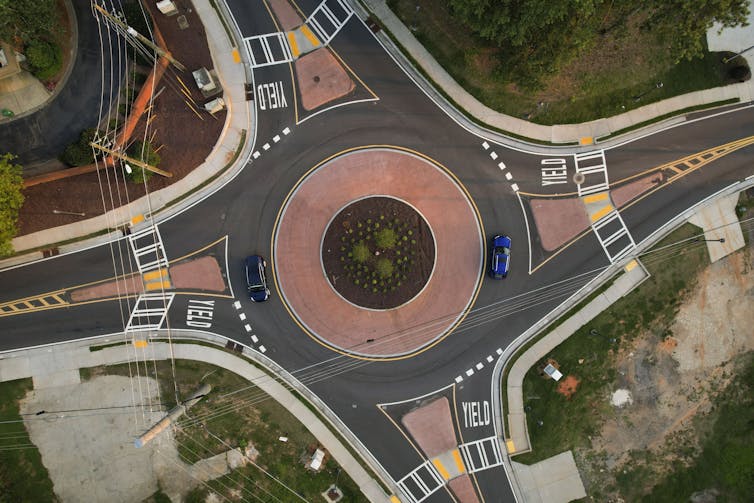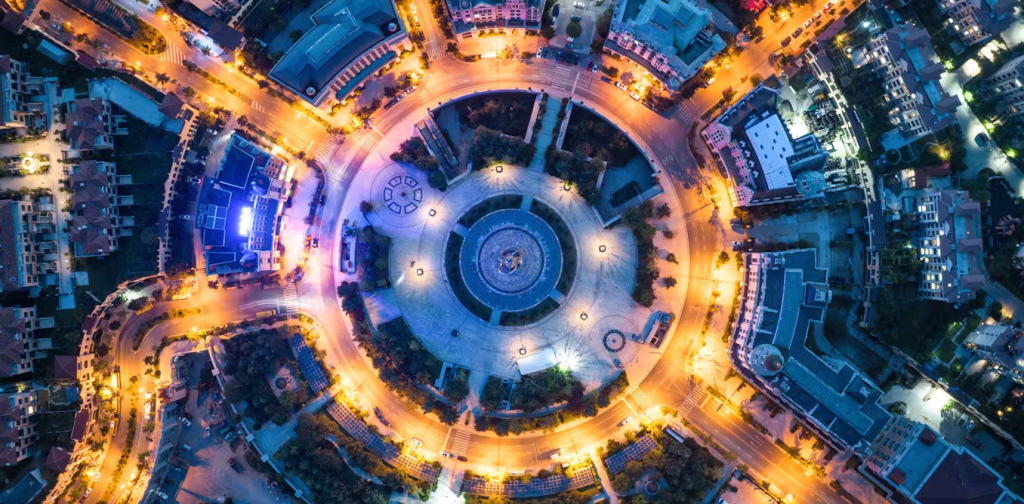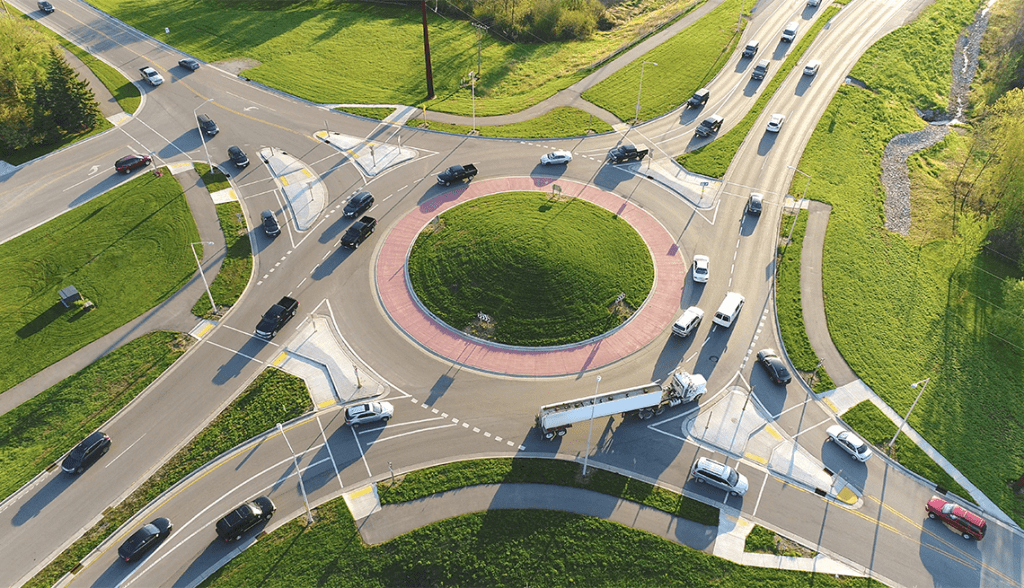Roundabouts are becoming an increasingly common feature on roads across the United States. While some drivers love their efficiency, others approach these circular intersections with a mix of caution and confusion. So, what exactly are roundabouts, and why are they being adopted so widely? These traffic structures, designed to improve safety and traffic flow, are more than just an alternative to traditional intersections—they represent a shift toward smarter and safer roadways.
Here’s everything you need to know about roundabouts, including their history, functionality, and the significant safety benefits they bring to our roads.

Modern roundabouts can have one or two lanes, and usually have four exit options. AP Photo/Alex Slitz
What Are Roundabouts, and How Do They Work?
Roundabouts, also known as traffic circles or rotaries, are circular intersections where traffic flows counterclockwise around a central island. Instead of using traffic lights or stop signs, roundabouts rely on yield-at-entry rules, where vehicles entering the roundabout must yield to traffic already circulating within it.
The design encourages lower vehicle speeds and smoother traffic flow, as cars enter and exit at angles rather than crossing each other at 90-degree intersections. Most roundabouts also include pedestrian crossings and splitter islands (raised curbs) to help manage vehicle speeds and enhance safety for pedestrians.

The History of Roundabouts: From Europe to America
Roundabouts may seem like a modern traffic innovation, but their roots go back centuries. As early as the 1700s, circular intersections were built in European cities like Bath, England, and Paris, France. In the United States, Pierre L’Enfant incorporated several circular intersections into his design for Washington, D.C. However, these early designs lacked the safety and functionality features we associate with modern roundabouts.
The turning point came in the 1950s, when engineers in the United Kingdom introduced yield-at-entry regulations to improve safety and traffic flow. Vehicles entering the roundabout were required to yield to those already inside, reducing congestion and the likelihood of accidents. This innovation spread rapidly across Europe and Australia, and by the 1990s, roundabouts began appearing in North America.
The first modern roundabout in the United States was built in Summerlin, a community in Las Vegas, in 1990. Since then, roundabouts have gained popularity, with over 10,000 now in operation across the country.
Why Are Roundabouts Safer Than Traditional Intersections?
The safety benefits of roundabouts are one of the main reasons they’re becoming a preferred choice for traffic engineers. Traditional four-way intersections, particularly those controlled by stop signs or traffic lights, are hotspots for accidents due to their numerous conflict points—locations where vehicles’ paths cross.
Here’s a comparison:
- Traditional Intersections: A four-way intersection has 32 conflict points, which include crossing, merging, and diverging paths. Right-angle collisions, often referred to as “T-bone” crashes, are common and can result in severe injuries or fatalities.
- Roundabouts: These intersections reduce the number of conflict points to just eight. Vehicles enter and exit at angles, significantly lowering the likelihood of right-angle crashes.
According to the Federal Highway Administration (FHWA), replacing a stop-controlled intersection with a roundabout can reduce serious and fatal crashes by 90%. When a roundabout replaces a signalized intersection, the reduction in serious and fatal crashes is nearly 80%.
Efficiency and Environmental Benefits of Roundabouts
Safety isn’t the only advantage roundabouts offer—they’re also highly efficient. Unlike traditional intersections, where vehicles frequently stop and start, roundabouts keep traffic flowing continuously. Here’s how this benefits drivers and the environment:
- Reduced Congestion: Roundabouts eliminate the stop-and-go pattern of traffic lights, allowing vehicles to move smoothly. This results in shorter wait times and reduced congestion during peak hours.
- Lower Fuel Consumption: Continuous traffic flow means fewer stops and starts, which translates to better fuel efficiency for vehicles.
- Decreased Emissions: Reduced idling times and smoother driving contribute to lower vehicle emissions, making roundabouts an eco-friendly choice for urban planning.
In addition to these benefits, roundabouts allow drivers to perform U-turns more easily, providing greater flexibility in navigating roadways.
Where Are Roundabouts Most Commonly Found?
Roundabouts are most frequently installed in areas with high traffic volumes or a history of accidents. However, they’re not necessary for every intersection. City planners typically prioritize roundabouts in locations where they can have the greatest impact on safety and traffic flow.
Some states, like New York and Virginia, have adopted a “roundabout first” policy, meaning roundabouts are the default choice when building or upgrading intersections. States like Florida have embraced the concept wholeheartedly, with approximately 750 roundabouts in operation. In contrast, states like North Dakota, South Dakota, and Wyoming have fewer than 50 combined, likely due to lower population densities and traffic volumes.

Challenges and Public Perception of Roundabouts
Despite their many benefits, roundabouts aren’t without their critics. Some drivers find them confusing or intimidating, especially if they’ve never encountered one before. Learning how to navigate a roundabout—yielding to circulating traffic, signaling before exiting, and staying in the correct lane—can take some getting used to.
Public perception of roundabouts often improves once drivers become familiar with them. Studies have shown that residents who initially opposed roundabouts tend to support them after experiencing their benefits firsthand.
The Future of Roundabouts in the U.S.
Roundabouts are here to stay. Over the past two decades, the number of roundabouts in the U.S. has grown from just 356 in 2000 to over 10,000 today. Their widespread adoption reflects a shift toward safer, more efficient roadway designs.
The FHWA continues to recommend roundabouts as the safest option for intersections, and many states are following suit by incorporating them into their transportation plans. With advancements in design and public education, roundabouts are likely to become even more common in the years ahead.

Conclusion: Roundabouts Are More Than Just a Traffic Solution
Roundabouts represent a smart, forward-thinking approach to road safety and efficiency. By reducing conflict points, encouraging continuous traffic flow, and lowering vehicle emissions, they address many of the challenges posed by traditional intersections.
While some drivers may still feel hesitant about using roundabouts, their proven safety and environmental benefits make them a valuable addition to any community’s infrastructure. As more states embrace this innovative design, roundabouts will continue to transform the way we think about roadways—making them safer, greener, and more efficient for everyone.
So, the next time you encounter a roundabout, take a moment to appreciate its thoughtful design and the many benefits it brings to the road.